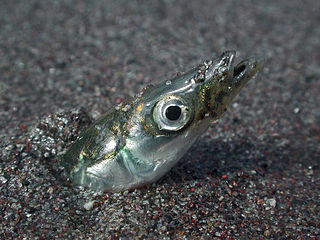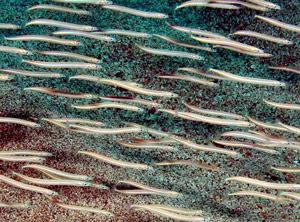
Moray eels, or Muraenidae, are a family of eels whose members are found worldwide. There are approximately 200 species in 15 genera which are almost exclusively marine, but several species are regularly seen in brackish water, and a few are found in fresh water.

Ophichthidae is a family of fish in the order Anguilliformes, commonly known as the snake eels. The term "Ophichthidae" comes from Greek ophis ("serpent") and ichthys ("fish"). Snake eels are also burrowing eels, they are named for their physical appearance, they have long, cylindrical snakelike bodies. This family is found worldwide in tropical to warm temperate waters. They inhabit a wide range of habitats, from coastal shallows and even rivers, to depths of above 800 m (2,600 ft). Most species are bottom dwellers, hiding in mud or sand to capture their prey of crustaceans and small fish, but some are pelagic.

A sand lance or sandlance is a fish belonging to the family Ammodytidae. Several species of sand lances are commonly known as "sand eels", though they are not related to true eels. Another variant name is launce, and all names of the fish are references to its slender body and pointed snout. The family name means "sand burrower", which describes the sand lance's habit of burrowing into sand to avoid tidal currents.

The cusk-eel family, Ophidiidae, is a group of marine boney fishes in the order Ophidiiformes. The scientific name is from the Greek ophis meaning "snake", and refers to their eel-like appearance. True eels, however, diverged from other ray-finned fish during the Jurassic, while cusk-eels are part of the Percomorpha clade, along with tuna, perch, seahorses, and others. Unlike true eels of the order Anguilliformes, cusk-eels have ventral fins that are developed into a forked barbel-like organ below the mouth. In the true eels by contrast, the ventral fins are never well-developed and usually missing entirely.

Gymnothorax is a genus of fish in the family Muraenidae found in Atlantic, Indian and Pacific Ocean. With more than 120 species, it the most speciose genus of moray eels.

Heteroconger is a genus of marine congrid eels. These small, slender garden eels live in groups where each individual has its own burrow. Usually, only the head and front half of the body is visible. The greatest species richness is in the Indo-Pacific, but species are also found in the warmer parts of the Atlantic and the eastern Pacific. Its name relates to how a huge colony of the eels looks swaying in the current.

Raitt's sand eel, also known as the lesser sand eel, is a small semi-pelagic ray-finned fish found in the North Atlantic Ocean. The Raitt's sand eel is member of the family Ammodytidae which includes all 31 species of sand eels, often referred to as sand lances. Contrary to their name sand eels, including Raitt's sand eel, are not true eels and instead belong to the order of “weever-like” fishes, the Trachiniformes.

An eel is a ray-finned fish belonging to the order Anguilliformes, which consists of eight suborders, 19 families, 111 genera, and about 800 species. Eels undergo considerable development from the early larval stage to the eventual adult stage, and most are predators.

Ariosoma is a genus of marine congrid eels.
Bascanichthys is a genus of eels in the snake eel family Ophichthidae. It currently contains the following species:
Ichthyapus is a genus of eels in the snake eel family Ophichthidae.

Protanguilla palau is a species of eel, the only species in the genus Protanguilla, which is in turn the only genus in its family, Protanguillidae. Individuals were found swimming in March 2010 in a deep underwater cave in a fringing reef off the coast of Palau.

Ammodytes is a genus of sand lances native to the northern oceans.

Gymnammodytes is a genus of sand lances native to the eastern Atlantic Ocean, the Mediterranean Sea and the southwestern Indian Ocean along the coast of Africa.
Hyperoplus is a genus of sand lances native to the northeastern Atlantic Ocean.
The white-ring garden eel, also known as the Cape garden eel in Mexico, is an eel in the family Congridae. It was described by Garry I. McTaggart-Cowan and Richard Heinrich Rosenblatt in 1974, originally under the genus Taenioconger. It is a marine, tropical eel which is known from the Gulf of California, in the eastern central Pacific Ocean. It is known to dwell at a depth of 20 m (66 ft), and inhabits sand sediments near reefs, where it forms burrows in nonmigratory colonies. Males can reach a maximum total length of 80 cm.
The Oriental worm-eel, also known as the Oriental snake eel, the Oriental sand-eel or the finny sand-eel, is an eel in the family Ophichthidae. It was described by John McClelland in 1844, originally under the genus Dalophis. It is a tropical, marine and freshwater-dwelling eel which is known from the Indo-Western Pacific, including Somalia, South Africa, India, Papua New Guinea, Tahiti, French Polynesia, Indonesia, Oman, Palau, New Caledonia, the Philippines, Sri Lanka, Seychelles, and Vanuatu. It dwells at a depth range of 0 to 3 metres, and forms burrows in sand and mud sediments in estuaries, rivers, and inshore turbid waters. Males can reach a maximum total length of 36 centimetres (14 in), but more commonly reach a TL of 25 centimetres (9.8 in).
The Short-maned sand-eel is an eel in the family Ophichthidae. It was described by Geoffrey Palmer in 1970. It is a marine, tropical eel which is known from the Indo-Pacific, including the Red Sea, the Aldabra Islands, the Hawaiian Islands, and the Marquesan Islands. It is known to dwell at a depth of 60 metres (200 ft), and leads a benthic lifestyle. Males can reach a maximum total length of 59 centimetres (23 in).
Phaenomonas longissima, also known as the short-maned sand eel in St. Helena, is an eel in the family Ophichthidae. It was described by Jean Cadenat and Émile Marchal in 1963, originally under the genus Callechelys. It is a marine, tropical eel which is known from the Atlantic Ocean, including Ascension Island, St. Helena, Brazil, Senegal, Ghana, and Cape Verde. It dwells at a depth range of 25 to 35 metres, and forms burrows in sand and mud sediments on the continental shelf. Males can reach a maximum total length of 50 centimetres (20 in).
The elastic eel is an eel in the family Ophichthidae. It was described by George S. Myers and Charles Barkley Wade in 1941. It is a tropical, marine eel which is known from the eastern central and southeastern Pacific Ocean, including Colombia, Ecuador, Costa Rica, and Mexico. It dwells at a depth range of 1–35 metres, inhabiting sandy bottoms. Males can reach a maximum total length of 53.5 centimetres.











